The hard drive in my laptop has been a bit flaky lately so I decided to replace it. The original drive is a 4200rpm Toshiba MK802GAS 2.5″ 80GB IDE drive. It was also running a bit hot and the laptop doesn’t really ventilate the drive much, so I was reluctant to replace it with a faster 5400rpm or 7200rpm drive that might run even hotter.
Fortunately there are now replacement drives based on flash memory rather than spinning disks. When they first appeared they were expensive and slow, but they are improving in both respects. Performance is now equaling or exceeding the fastest traditional disks. Cost per gigabyte is still much lower with traditional disks, but prices have come down enough that it is possible to get a usable sized disk for a reasonable price.
Since my laptop is IDE, my choices were limited. In Taiwan only Transcend has IDE SSDs on the market. (There are many more choices for SATA.) The two choices then were whether to get MLC or SLC technology and what size. In general MLC write performance lags SLC write performance significantly, but SLC is much more expensive. I eventually settled on the 32GB MLC model: Transcend TS32GSSD25-M. I bought it for TW$3488 (US$100.03) including shipping on PC Home.
When I was researching what to buy I noticed a very peculiar thing. There seemed to be two different drives with the same part number! Older benchmarks on this model showed read speed of barely over 20MB/s while newer benchmarks showed read speed over 65MB/s. It turns out that Transcend updated the hardware sometime in late 2008 and didn’t bother to change the part number. They will probably lose a lot of sales because of this because anyone who researches the performance will probably see the terrible old benchmarks and bad reviews.
Here’s what you should see on the box with the new version. The important part is apparently the “JMICRON” part in the upper right of the label which indicates that it uses the newer controller hardware:
UPDATE: It appears that not all new models have “JMICRON” on the label on the back. One way to tell the difference is that the label on the new models has a red border while the label on the old models has a blue border.
Here’s the label on the drive itself:
The important parts here are the Hardware Level of 6872-S1 and the manufacture date “092” which indicates it was made in the 2nd week of 2009. If you have this or better you should have the newer, faster version.
Let’s see how it measures up when compared to the old drive. First we’ll run a read benchmark across the disks with Medium speed/accuracy and 2MB block size:
Old:
New:
The new drive blows the doors off the old drive at 3.3 times faster the average speed. Comparing the minimum speeds and random access, the new drive shines even brighter. Two advantages SSD drives have are uniform performance across the disk, and no “seek” time. Seek time is how long it takes a traditional disk to reposition the read/write head to a different part of the disk. This tends to have a much bigger impact on realistic performance because a typical workload does not tend to do long sustained reads or writes but instead accesses lots of small files and programs scattered across a disk.
Next let us do a file benchmark. This uses both read and write at various blocksizes. I’m using a 128MB file and 1 second delay:
Old:
New:
This is where we see the drawbacks of MLC technology; the write speeds lag read speeds significantly. On an SLC drive the read and write speeds would be more comparable. Even so, the write speed on the new drive is still about 10MB/s faster than the old.
And lastly a random access read test. This tries reading data at various block sizes from random locations on the disk, then computes an average access time and total read speed during the operation.
Old:
New:
Again, this is one area where SSDs really excel. There’s no seek time, so the access limit here is the read time, and performance greatly surpasses that of the old disk.
But more important is how does it feel? Windows boots up extremely fast and doesn’t have the “sluggish” feeling for the first couple of minutes like with a traditional disk. This is probably mostly due to the lack of seek time, but I’m sure that the read speed increase and the fact that it is a fresh install of Windows also helps. I also upgraded my RAM from 1GB to 2GB at the same time, so that probably also is a factor.
And so far I don’t feel confined by the smaller sized drive. Most people should have plenty of room with even 16GB drives as long as they keep away from video files and keep the music files to a minimum. I was using a bit more than 32GB before, but that includes a lot of junk that I don’t really need to carry around. I’ve got all my essentials now and still have plenty of space left.
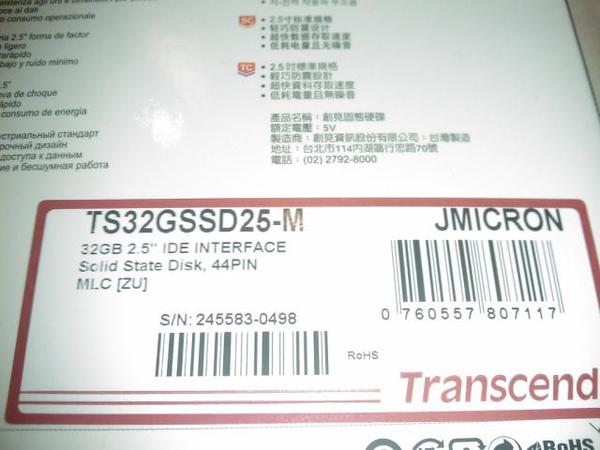
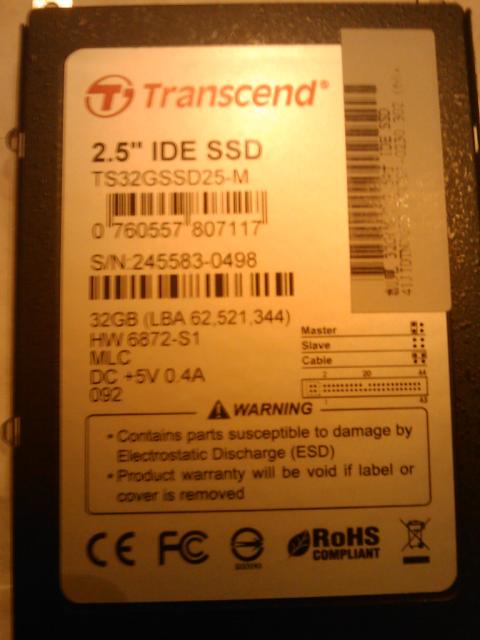
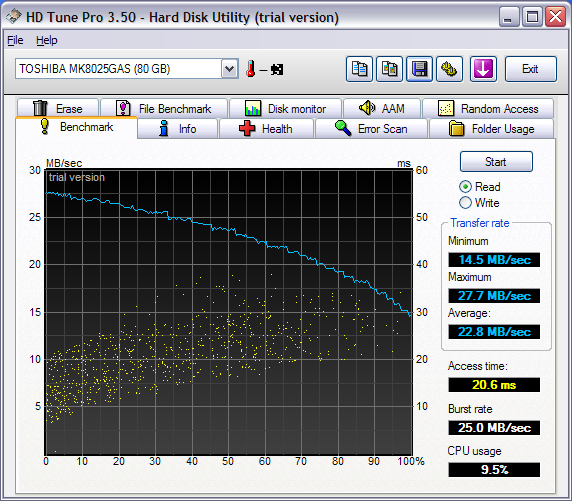
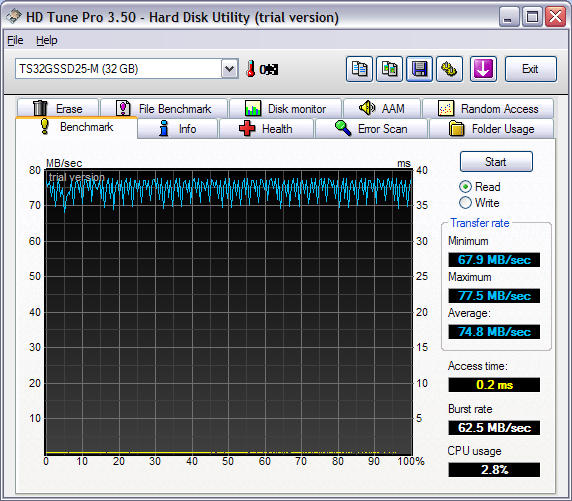
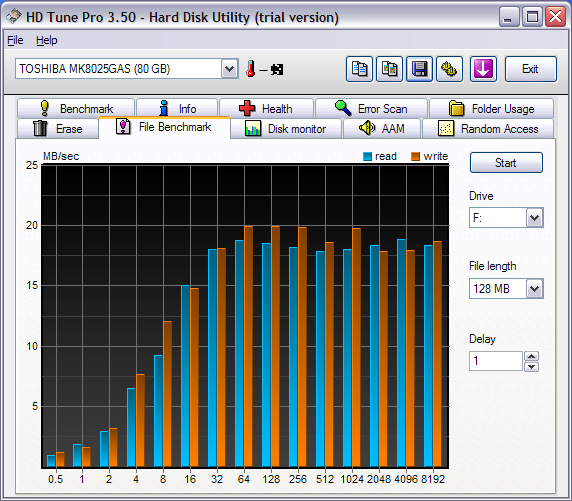
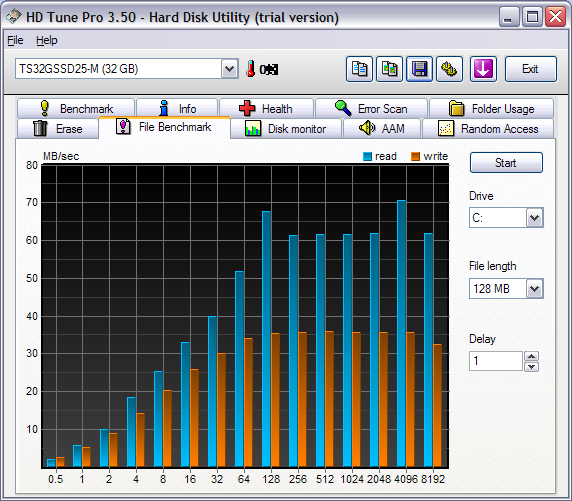
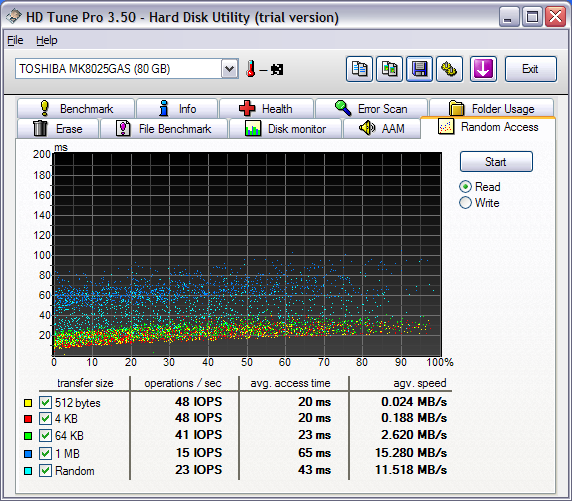
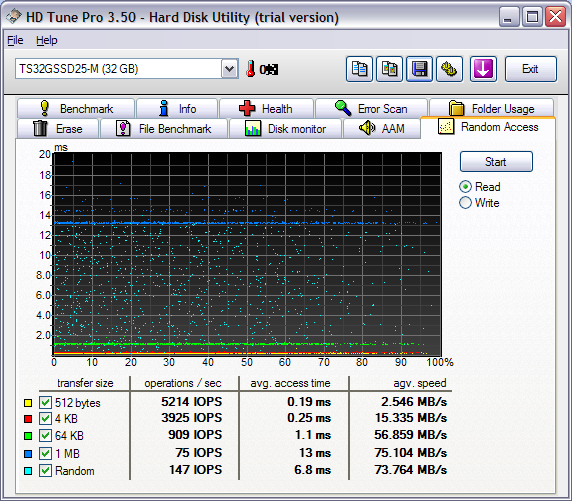
James:
Thanks for this…
It’s about the only ‘real world’ benchmark for this drive on the web at present.
I ordered the same Transcend drive last week and will be replacing a Toshiba 80 GB 5400 RPM drive in a PowerBook G4.
I’m a bit concerned about the write speed and the overall life span of the drive, but I was willing to take the chance for comparable performance overall and a silent laptop.
Perhaps I should try to find a Mac tool to test the original drive and the new Transcend…
Peter B.
—–
The main benchmark I came across using the new drive is one in Japanese:
http://www.watch.impress.co.jp/akiba/hotline/20081101/ni_ctr32.html
I don’t read Japanese except where they use Kanji and it has the same meaning as the Chinese. The interesting part is that they sell it as TS32GSSD25-M(高速版) where the part in the parens means “High Speed Edition.”
If I hadn’t come across this benchmark I would have assumed the performance sucked because all the other benchmarks I saw up to that point were from last summer on the old version.
Below are some typical Write-Read specs from the Toshiba (5400 RPM) drive I replaced and the Transcend drive.
(I couldn’t find a free Mac utility to let me run other tests.)
I’m content with this ‘outcome’. The computer feels quicker under most circumstances, though as you can see, writing large(r) files tends to bog the Transcend down.
My ‘testbed’ is a Powerbook G4, 1.5 Ghz, 512 MB RAM.
Thought I’d post this here to ‘amplify’ James’ experience.
Peter B.
—–
128 MB
Toshiba – Write: 31.9 MB/s – Read: 32.9 MB/s
Transcend – Write: 45.8 MB/s – Read: 77.6 MB/s
256 MB
Toshiba – Write: 31.9 MB/s – Read: 32.9 MB/s
Transcend – Write: 45.3 MB/s – Read: 77.4 MB/s
512 MB
Toshiba – Write: 30.1 MB/s – Read: 32.6 MB/s
Transcend – Write: 45.4 MB/s – Read: 76.2 MB/s
1 GB
Toshiba – Write: 30.8 MB/s – Read: 32.4 MB/s
Transcend – Write: 29.2 MB/s – Read: 72.7 MB/s
2 GB
Toshiba – Write: 30.6 MB/s – Read: 32.8 MB/s
Transcend – Write: 26.3 MB/s – Read: 74.8 MB/s
4GB
Toshiba – (Untested)
Transcend – Write: 24.6 MB/s – Read: 77.3 MB/s
—–
Thanks for those stats. It is interesting that the write speed declines as file size increases. I’ll have to see if that is true for mine as well. Your read speeds are really good though!
I myself have bought both Transcend 32GB and 64GB MLC version for upgrade in 2 very old IDE laptops. Compaq Presario 1700 that originally has a 6GB HD and for experiemental purposes, a Dell Latitude CP which has a 3GB HD. There are plenty of tests and reviews with SATA SSD on the latest or recently new laptops (1 or 2 years old) but none to test on vintage laptops.
There’s lots of issues with MLC that studders, but i’m curious if the studdering is a factor of the throughput speed of modern PCs. My Dell CP laptop would be lucky to be ATA33 speed and would thus never reach the maximum speed rating of these Transcend MLC units – if this is the case, would studdering still be an issue??? I recall it had something to do with a lack of buffer in the JMicron chip when the data bursts at peak max. speed.
Anyways, i’m away overseas and won’t be able to confirm any tests until I get back in over a months time.
I’ve read about the stuttering issue but have yet to experience it. The only time I’ve had slowdowns is under heavy SSD activity and this is the type of load that if anything would have been slower on the old disk.
By the way, the laptops with 3GB and 6GB original disks probably were only ATA33 interface anyways, so you’ll be limited by the interface speed.
Hi James, I just want to get back to you on my results with the one Transcend 64GB MLC drive i’m using in the Compaq laptop. I will have to say that i’m very impressed with the speed running Win2K. My boot time is less than 40 seconds (after bios post) which is by no comparison to what I use to have to wait with the old hard drive. Also i’m not experiencing any of this stuttering issue after many IE6 web window sessions along with the downloading at the same time.
There’s plenty of info online about how poor these Transcend units perform because of the ‘crappy’ JMicron controller chip they use. I suppose this would be a key issue on modern PCs today but for those still on IDE, they’re a great upgrade.
I’ve yet to report on my progress with the Transcend 32GB SSD MLC for the Dell laptop later this year. With the way how fast these old laptops can run, it really confirms the race of buying new and faster PCs means nothing with Microsoft keeps dishing out pigware after another. Really, how productive are we talking about if we have to wait so long just to have the PC booted or coming out of hibernation.
Good to hear you had some good success with the drives.
Hi!
I tried TS32GSSD25-M older version.
HW: 8190AC-S1
It was realy slow in my iBook G4.
2x slower than 5 years old original HDD.
What can I do?
Can i download new firmware, from anywhere?
It is not a firmware problem, it is a completely different chipset on the older version. Sorry.
Hi James, thank you very much for posting such useful post about upgrading HDD to SSD.
I have a old laptop for business use and it’s Compaq Evo N200, comes with ATA 33 20Gb hard disk, as SBQ’s Compaq Presario. I’m considering upgrading to a 16 or 32Gb but is wondering how much difference would that be given the limitation of Max 33Mb/s transfer rate. Since the laptop comes with ULV PIII 700 with max 192 Mb ram. Price-wise I’m uncertain to buy a new netbook like HP mini 5102 or spend USD 100 to SSD. Any advice?
SBQ: Can you elaborate what kind of performance improvement after switching to a SSD? Which SSD brand would you recommend for PATA, like kingspec?
Thank you very much for your post again!
If the screen size doesn’t bother you, upgrading to a netbook will be much faster.
Thank you for your advice. I did take some time to research using google, and found out that a IDF-CF card upgrade would be more sensible and cost-efficient. I’m going to get a 8G or 16Gb CF card and upgrade it soon, coz the internal IDE HDD takes much longer for read/write and release heat a lot.
The only problems seem to be getting a good fixed mode CF card with UDMA mode, ensuring that Windows XP can be installed and boot from the CF card.
I own two of these drives. One is very fast and was manufactured 0926-ish, the other is 0902. It’s also fast but stutters unlike the other 0926. IOMeter 4k 100% random writes clearly exhibit only 6 op/s, while the other was between 64-171.
What’s interesting is the manufacturing date… mine is 0902, the blog’s is 092. I’d like to see IOMeter results on the blog’s drive to ensure what is a safe date of this drive to buy. Right now I think 0926.. 26th week of 2009 is a very safe date.
Also there is a firmware update from Transcend for these drives 4/13/10. It is 090331. When I updated my 0902 version with firmware 081209, the 512 and 4k writes improved 10x!!!, however there appears to be a bug in the firmware since the sequential read and writes are pegged at 33mb/s. It seems like it’s locked to ultra dma 2 speeds. I contacted Transcend about this issue.
Thanks for the note about the new firmware. I was going to install it today but it apparently will have to nuke the data on the drive to install. I was planning to upgrade to Windows 7, so I’ll take this opportunity to do both. (Windows XP to Windows 7 requires a fresh install anyways.)
I’ve just updated the firmware in my drive and installed Windows 7 on it. I’ll run some benchmarks a little later. My drive originally had firmware 081209 on it. While looking into the firmware issue, I found that 090331 from Transcend is just the standard firmware upgrade available from various SSD manufacturers, and that the latest for this drive is actually 090928. I was able to get this version from Super Talent’s support site, and had no problem installing it. Maybe this version will solve the slow transfer issue you observed with the 090331 version. As promised, the drive was wiped during firmware upgrade. I had made two backup copies beforehand. A friend also pointed out to me that Windows 7 has various SSD optimizations, including support for TRIM which lets the drive and OS cooperatively manage unused space.
The HD Tune Pro read benchmark and random read benchmark are both pretty much the same as before. The file benchmark was significantly better than before, indicating that Windows 7 improved file system perfomance significantly.
A followup. In one desktop and laptop it maxed out at UDMA2 33MB/s speed and was detected as a SATA drive with Crystal Disk Info . In a friend’s laptop it ran full speed. So becareful out there. I also tried 4 different Super Talent firmwares… none of them restored the full speed. Regardless even while capped at UDMA2 I continued to use it, performance is still awesome… but then it failed. No detection by the BIOS on 3 different PCs or even in a USB enclosure. It’s now RMAed for warranty. I hope I get a new version.
Hi. I’m hoping that someone reading this can help.
I have beeen trying to upgrade a Compaq Evo n610c and an Armada M300 to SSD ( either CF or SSD ) with no success. I have tried a number of SSD’s but have generally failed at the last part of installs ( Xp ). I have tied default Format plus variations ( 512 blocks upwards ) and no real luck.
I managed to install Xp on a CF but it was so slow that again I gave up.
Has anyone done this conversion with success and if so is there any chance of pointing me to the working procedure?
These laptops have very limited BIOS and I am aware that if I considered a more modern laptop and or Windows7 I could make the task easier but I am committed to the Evo n610c for many reasons : Still cuts the mustard for general processing and internet use, one of the most robust units made and great for mobile use and vehicle diagnostics. I have 2 of these and look after 3 others so an SSD/CF conversion would remove the most fragile component form the laptop.
Hoping someone can help. Cheers!
Hey 2shed,
SATA based SSDs are regularly on sale in the U.S. for $1.5 USD per GIG. After getting a tiny SATA-PATA adapter (google: POS:STI-P), I finally moved all PATA laptops (2001 Sony, 2005 Dell) to SATA based Intel SSDs.
There are physical size precautions. In the Sony, the PATA drive was inside the laptop so there was plenty of room. The Dell has a drive bay. However after removing the SSD out of it’s 2.5″ enclosure I was able to barely fit it.
It could be an alternate solution since PATA SSDs are getting expensive and difficult to find.
Hi razel. Thanks for a reponse but not too sure about it being a solution to my troubles. There are numerous items and vids ( YouTube ) showing impressive operation of Evo’s running Xp from SSD’s and CF’s but nothing about how they managed it. Lot’s of “How to install an SSD ( mechanically )” = HoHum and lots of “SpeedyBoys” showing the finished article but absolutely no MEAT on the way of getting Xp to install ( quickly – I am re-installing Xp Pro on one of my Evo 610c’s and it is saying 25 mins to go, having taken over an hour to get there and it will take at least another hour to finish ) and then run properly.
So; there are lot’s of machines out there using IDE CF/SSD on Pentium 4 laptops so it works – but how.
Anybody know Merlin the Magician?
Cheers and Happy Xmas ( if you believe in the social side of it ).
Thanks for the article James Lick, even if it’s 2012 I’m finding it very useful now.